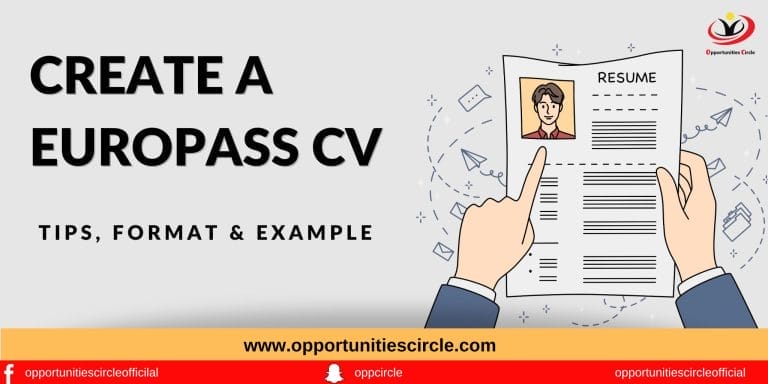In an era of global connectivity and a highly competitive job market, is compelling CV/resume is essential for individuals seeking to stand out among their /*656peers. The Europass CV , a standardized document widely recognized and accepted throughout Europe, has become a valuable tool for job seekers and educational institutions. This essay will guide you through the process of creating an effective Europass CV, covering its significance, step-by-step creation, essential tips, and the art of tailoring it to your specific needs.
What is a Europass CV & Why is it Important?
The Europass CV is a standardized document format designed to facilitate cross-border mobility and make it easier for employers and educational institutions to assess an individual’s qualifications and competencies. It is particularly valuable for those seeking opportunities in Europe, as it ensures uniformity and clarity in presenting one’s professional and academic history.
The importance of the Europass CV lies in its ability to:
- Enhance Mobility:
This CV helps individuals move seamlessly across borders within Europe, making it easier to apply for jobs or educational programs in different countries.
- Clarity and Transparency:
It offers a clear, structured format for presenting your qualifications, making it easier for employers and institutions to understand your background.
- International Recognition:
Europass CV is widely recognized and accepted by employers, educational institutions, and organizations across Europe, increasing your chances of success.
How to Create a Europass CV?
You must be thinking about How to Create a Europass CV easily. To help you in this regard, we have provided all the details regarding the importance of a Europass CV. We have also provided the important steps to create a Europass Curriculum Vitae.
Essential Steps to Create a Europass CV:
Creating an effective CV is a straightforward process that can be broken down into several key steps:
- Gather Information:
Collect all relevant information, including personal details, education history, work experience, skills, and qualifications.
- Visit the Europass Website:
Go to the official Europass website (europass.eu) to access the online CV builder.
- Choose Your Template:
Select a template that suits your preferences and the nature of your application.
- Fill in Your Information:
Input your personal and contact details, education and training history, work experience, language skills, and any other relevant information.
- Highlight Your Skills:
Emphasize your skills and competencies, using clear and concise language. Be sure to include both hard and soft skills.
- Review and Edit:
Carefully review your CV for accuracy, completeness, and consistency.
- Download and Save:
Once you are satisfied with your Europass CV, download it in PDF format and save a copy for future use.
Tips for Crafting the Best Europass CV:
Creating an impressive Europass CV involves more than just filling in the blanks. Here are some essential tips to help you craft the best Europass CV:
- Clarity and Conciseness:
Keep your CV clear and concise. Use bullet points and avoid jargon.
- Relevance:
Include only relevant information. Tailor your CV to the specific job or program you are applying for.
- Professional Presentation:
Use a professional tone and format. Pay attention to grammar and spelling.
- Use Action Verbs:
Start bullet points with action verbs (e.g., “achieved,” “managed,” “developed”) to describe your accomplishments.
- Quantify Achievements:
Use numbers or percentages to quantify your achievements (e.g., “increased sales by 20%”).
- Emphasize Key Skills:
Highlight your most important skills and competencies relevant to the position.
- Update Regularly:
Keep your Europass CV up to date with your latest experiences and qualifications.
Tailoring Your Europass CV:
One of the key elements of a successful Europass CV is tailoring it to match the specific requirements of the job or program you are applying for. Here’s how to do it:
- Research the Position:
Study the job or program requirements carefully to understand what the employer or institution is looking for.
- Customize Your CV:
Modify your CV to emphasize the skills and experiences that are most relevant to the position.
- Use Keywords:
Incorporate relevant keywords from the job description to ensure your CV aligns with the employer’s expectations.
- Highlight Relevant Experience:
Prioritize and prominently feature experiences that directly relate to the position or program.
Format of a Europass CV:
- Personal Information:
– Full Name
– Address
– Phone Number
– Email Address
– Date of Birth
– Nationality
- Objective:
– Optional: A brief statement about your career goals or what you’re looking for in a job or educational program.
- Work Experience:
– List your work experience in reverse chronological order.
– Include the name of the company, location, your job title, dates of employment, and a brief description of your responsibilities and achievements.
- Education and Training:
– List your educational background, starting with the most recent.
– Include the name of the institution, location, the title of your qualification, the level of education (e.g., bachelor’s degree), and the dates you attended.
- Skills:
– Enumerate your skills, both technical and soft skills.
– Categorize them for clarity (e.g., Languages, IT Skills, Communication, Leadership).
- Language Skills:
– List your language proficiency in each language, using a standardized scale (e.g., A1, A2, B1, B2, C1, C2).
– Specify your abilities in reading, writing, speaking, and understanding for each language.
- Additional Information:
– Include any additional information or qualifications that are relevant, such as certifications, licenses, or memberships in professional organizations.
- Interests:
– Optionally, provide a brief list of your hobbies or interests, which can help to give a well-rounded impression.
- References:
– Mention that references are available upon request, but do not include contact details.
Europass CV Template
Pros and Cons of the Europass CV
- It is widely recognized for jobs and educational purposes.
- The layout is simple.
- Suits all levels of job seekers.
- Available in multiple languages.
- Moreover, it is easy to edit.
- On the other hand, it is outdated and has limited templates.
- Inconsistent fonts throughout the CV.
- Limited options to edit and customize.
- Another con is that it is downloadable as a PDF only.
- Less suitable for creative industries.
Creating a Europass CV is essential for anyone seeking opportunities in Europe, whether in the job market or educational arena. It provides a standardized and widely accepted format that enhances your chances of success. By following the steps outlined in this essay, incorporating valuable tips, and tailoring your CV to specific requirements, you can present yourself in the best possible light and open doors to exciting opportunities across Europe. Remember, a well-crafted Europass CV is your passport to success on the European stage.





